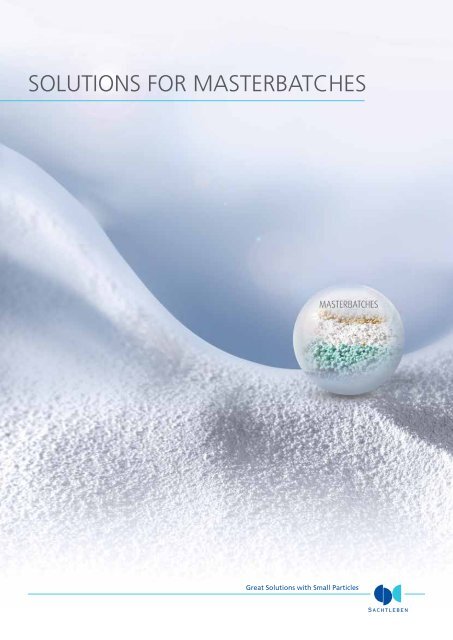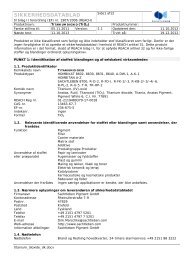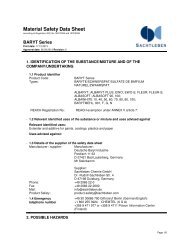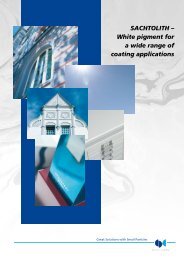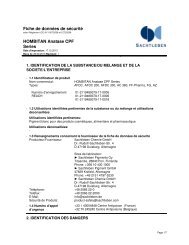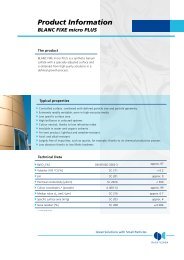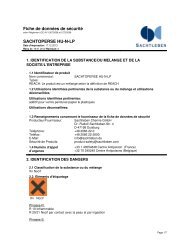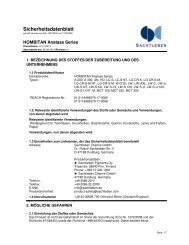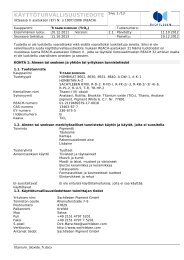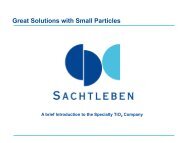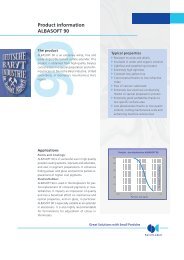Solutions for Masterbatches - Sachtleben Chemie GmbH
Solutions for Masterbatches - Sachtleben Chemie GmbH
Solutions for Masterbatches - Sachtleben Chemie GmbH
- No tags were found...
You also want an ePaper? Increase the reach of your titles
YUMPU automatically turns print PDFs into web optimized ePapers that Google loves.
<strong>Solutions</strong> FOR <strong>Masterbatches</strong>Great <strong>Solutions</strong> with Small Particles
Great solutions with small particlesWho we are<strong>Sachtleben</strong> is a leading manufacturer of top-quality chemicalproducts with a unique range of white pigments and extenders.The history of the company‘s involvement at its Duisburglocation stretches back more than one hundred years.<strong>Sachtleben</strong> supplies the entire world with innovative productsin the fields of titanium dioxide and functional additives. Ouroutstanding product quality is matched by our excellence inproblem-solving capabilities and technical Customer Service. Themain fields of application <strong>for</strong> <strong>Sachtleben</strong>‘s products can be found,<strong>for</strong> instance, in synthetic fibers, paints and coatings, plasticsand paper. <strong>Sachtleben</strong> also manufactures specialized products<strong>for</strong> the foods, pharmaceuticals and cosmetics industries and isthe right address in the field of chromatography and catalysisas well as the production of construction materials.As a specialist in ultra-small inorganic particles, <strong>Sachtleben</strong>provides individual, innovative solutions to polymer-industryproblems. Our core capability is located in the production andfunctionalization of ultra-small inorganic particles. This know-howis based, not least of all, on our decades of experience in theproduction of the most diverse range of particles on a titaniumdioxide and zinc/barium basis. The challenge <strong>for</strong> us is now thedevelopment of tailor-made solutions to meet our customers’specific needs.Service<strong>Sachtleben</strong> has a far-reaching sales and marketing network,with the result that you will find highly qualified and capablecontacts on-the-spot in more than eighty countries.<strong>Sachtleben</strong> corporate policyBased on the understanding of our customer needs our keycompetence is manufacturing, application and development offine disperse inorganic solid particles. Our target is to providesubstantial economic value and unique functional advantages toour customers. We focus on areas where we have competitiveexpertise in technology, products or market intelligence. Constantlywe develop innovative products and solutions <strong>for</strong> themarkets we serve. In our daily operations we apply internationallyaccepted standards of Good Manufacturing Practice and act inaccordance with the law and self-imposed industryspecificobligations such as “Sustainable Development” and“Responsible Care ® ”. Continuous improvement of our processes,quality improvement of our products, of environmental andhealth protection and of safety are mandatory <strong>for</strong> our staff.certificationNaturally, quality management also includes that the development,production and sale of white pigments, extenders and productsof facilities that use sulfuric acid are certified according to thestandards of the Deutsche Gesellschaft für Qualitätssicherung,the German QA body. Our management system <strong>for</strong> the foodindustry is also subjected to regular inspections.Certification to ISO 9001:2000, ISO 14001, ISO 22000:2005and OHSAS 18001 are just some of the standards that our qualitymanagement system tests itself against. Our products andfacilities also con<strong>for</strong>m to “Kosher Mehadrin” and “Halal (TiO 2)(ZnS/BaSO 4)”.QualityQuality-awareness in development, production and all services<strong>for</strong> our customers is an essential element in our thinking and ouractions. Continuous improvement of our processes in order tooptimize the quality of our products, and of our environmental,health and industrial safety, are thus a basic obligation imposedon all our employees.2
Specialities <strong>for</strong> <strong>Masterbatches</strong><strong>Sachtleben</strong> products are already in use in a wide rangeof applications in the plastics industry. Our pigments,additives, fillers and extenders with their diverse functionsmeet the demanding needs of masterbatch producers,compounders, composite manufacturers, elastomer usersand the makers of PVC sections and films.TiO 2/ ZnS/BaSO 4technologyTITANIUM Dioxide• Anatase pigments• Rutile pigments• Ultrafine-particlesFUNCTIONAL Additives• Synthetic barium sulfate• Zinc sulfide• Lithopone<strong>Masterbatches</strong>Today masterbatches are the most wide-spread option to givefunction to polymers. In both polyolefins and engineering plastics,masterbatches are becoming ever more firmly established <strong>for</strong> usein the coloration of polymers. Two third of all plastics are coloredvia masterbatches. The masterbatch market itself is approximatelyequally split into black, white, colored and additive masterbatches.The majority of all thermoplastics is used <strong>for</strong> packaging material,others <strong>for</strong> electronics, automotive or construction. Customersnow increasingly require lower-cost coloration, greater flexibilityand ever more demanding mechanical properties. <strong>Masterbatches</strong>there<strong>for</strong>e have to offer multifunctional products in order to usethem in a broad variety of different application For white batches,<strong>for</strong> example, food contact approval is generally required <strong>for</strong>standard packaging qualities, even if some share would not beused <strong>for</strong> packaging of food. Another general requirement is thebluish white undertone whereas specialized batches <strong>for</strong> durableapplication or batches <strong>for</strong> coloring of multi-layer films are stillregarded as something special.Based on decades of experience in the production of the mostdiverse range of titanium dioxide and zinc/barium-based particles<strong>Sachtleben</strong> offers a broad variety of different pigments, additivesand fillers <strong>for</strong> all facets of masterbatches, independent of being<strong>for</strong> white, colored, additive or even black solutions.3
The SACHTLEBEN white pigments landscapeBrightening powerand undertoneThe brightening power of TiO 2pigments can also be describedas the ability to lighten the original color of plastics.TiO 2has a higher brightening power compared to all otherwhite pigments, as a result of its high refractive index. Its narrowparticle size distribution assures good hiding power, in additionto excellent brightening power and positive effects onundertone. In general, the smaller the particle size the bluer theundertone. <strong>Sachtleben</strong> supplies rutile pigment products <strong>for</strong>the entire undertone range, extending from bluish (e.g. R 405),neutral or slightly bluish (e.g. R 420) to warm yellowish (e.g. R 320).All <strong>Sachtleben</strong> anatase pigments are even more bluish but offer aslightly lower brightening power along with the lower refractiveindex. Zinc sulfide white pigments are second in refractive indexcompared to titanium dioxide. While SACHTOLITH is a pure bluishspecialty, bluish color toned Lithopone, a co-precipitate of zincsulfide and barium sulfate, is used together with high quality rutilepigments, predominantly in the masterbatch application.SACHTLEBEN PIGMENTS LANDSCAPEREL. BRIGHTENING POWERR 320NEUTRAL COLOR TONEdurableuniversal MBLow Lacinginorg. unteatedspecialtyRutile (SACHTLEBEN)Zinc sulfideAnatase (HOMBITAN)R420RD3RKB4RU 5R 630R 405RFK 2RFK 3SACHTOLITHHDSLOCR-KMCT 300LC-SLOCR-SMLithopone30% DSBLUISH UNDERTONE4
White pigments – Rutiles <strong>for</strong> outdoor applicationsSACHTLEBEN R 420SACHTLEBEN R 420 is an alumina-silica-zirconia surface-treatedhydrophobic rutile titanium dioxide pigment and combines outstandingdurability with excellent optical properties. SACHTLEBEN R 420‘sfine crystallite and particle sizes position it in the group of neutral/blue-undertone plastics grades. SACHTLEBEN R 420 is highlysuited <strong>for</strong> use in nearly all polymers Thanks to its high level ofresistance to outdoor exposure, it is particularly popular <strong>for</strong>use in products <strong>for</strong> outdoor service, including window-profiles,tubes, PVC and polyolefin films, etc.SACHTLEBEN RFK 3SACHTLEBEN RFK 3 is an alumina-silica-zirconia surface-treatedhydrophobic rutile titanium dioxide pigment, and combinesoutstanding durability with excellent optical properties. Its finecrystal and particle sizes position SACHTLEBEN RFK 3 in thefamily of blue-undertone plastics grades, especially <strong>for</strong> all kindsof outdoor application.SACHTLEBEN RD 3SACHTLEBEN RD 3 is an alumina-zirconia surface treated hydrophilicrutile titanium dioxide pigment and combines outstandingoutdoor durability with excellent optical properties, i.e., highbrightness and lightening power, opacity, excellent gloss andeasy dispersibility. SACHTLEBEN RD 3‘s crystal and particle sizesposition it in the group of neutral undertone plastic grades.SACHTLEBEN RD 3 is highly recommended <strong>for</strong> high-quality plastics,particularly those <strong>for</strong> exterior applications.SACHTLEBEN RKB 4SACHTLEBEN RKB 4 is a micronized rutile titanium dioxidepigment treated with alumina-silica-zirconia compounds.It combines excellent weather resistance with good opticalproperties. RKB 4 is especially designed <strong>for</strong> exterior applicationsbecause of its very high gloss retention and resistance.It is an excellent alternative in gel coats and plastic systemswhich are sensitiv regarding the organic treatment.<strong>Sachtleben</strong> R 420 sachtleben RFK 3 sachtleben rD 3 SACHTLEBEN RKB 4Titanium dioxide classification R2 R2 R2 R2Inorganic treatment(compounds based on:) AI, Si, Zr AI, Si, Zr AI, Zr AI, Si, ZrOrganic treatment Polysiloxane Polysiloxane Polyol PolyolTiO 2content [%] approx. 95 approx. 93 approx. 93 approx. 94Undertone neutral/bluish bluish neutral neutralWeathering stability excellent excellent very good excellentStability2025RFK 3R 420RD 3RKB 410098RFK 3R 420RD 3RKB 4CIE b*10CIE L*969459200 500 1000 1500 2000 25003000 3500900 500 1000 1500 2000 25003000 35005
White pigments – Rutiles <strong>for</strong> indoor applicationsSACHTLEBEN RFK 2 and R 405 "UNIVERSAL APPLICATIONS”SACHTLEBEN RFK 2 is an alumina surface-treated hydrophobictitanium dioxide pigment offering rapid dispersibility in a largerange of polymers in dry processing as well as in liquid plasticizers.SACHTLEBEN RFK 2‘s fine crystal and particle sizes positionthe product in the group of blue undertone plastics grades. Thisproduct is recommended <strong>for</strong> highly filled masterbatches basedon polyolefins and other thermoplastic polymers.SACHTLEBEN R 405 is an alumina surface-treated hydrophobictitanium dioxide pigment offering excellent dispersibility in alarge range of polymers. SACHTLEBEN 405‘s fine crystal andparticle sizes position it in the group of blue undertone plasticsgrades. SACHTLEBEN R 405 is particularly recommended <strong>for</strong> usein systems in which fineness of pigment dispersion in the polymeris the top priority: polyolefins, styrenics, engineering polymers,etc.. SACHTLEBEN R 405 permits production of highly pigmentedconcentrates, such as polyolefin masterbatches, <strong>for</strong> instance.SACHTLEBEN R 630 “LOW LACING”SACHTLEBEN R 630 is an alumina surface treated hydrophobictitanium dioxide pigment. It provides fast and excellent dispersibilityin various plastics. As a result of its fine crystal and particlesizes SACHTLEBEN R 630 belongs to the family of blue undertoneplastics grades. It combines excellent optical propertieswith wide resistance to lacing.Allround top per<strong>for</strong>manceCutting-edge products such as SACHTLEBEN R 630 must, of course,are superior to standard pigment products. SACHTLEBEN R 630provides the following benefits throughout the productionprocess:• Effectively no lacing, even at high pigment loadingsand processing temperatures• High bluish white tinting• Good powder properties reducing flow problems anddust production in feed systems• Readily wettable in a large range of polymer systems,assuring high throughput rates• Excellent dispersibility, permitting productionof extremely thin filmsApplicationsSACHTLEBEN R 630 is extremely well suited <strong>for</strong> all applicationfields which are subject to lacing:• Thin films• Co-extruded multi-layer films• Single and multi-layer bottles• <strong>Masterbatches</strong>• Credit and check cards• Blister packaging• Food packaging6
Lacing and dye build-upThe majority of quality titanium dioxide pigments are inorganicallycoated. These coating compounds, usually consistingof oxyhydrates of aluminum, silica or zirconium, improve thepigment‘s resistance to weathering, and also have benefits <strong>for</strong>its wetting behavior and resistance to flocculation.Operation of plastic processing lines at ever higher throughputrates also increases processing temperatures, turning thebeneficial effects of inorganic coatings to a disadvantage - nothaving been subjected to such temperatures be<strong>for</strong>e. The coatedpigment grades tend to emit water into the polymer melt, whilethe oxyhydrates are converted to oxides.This loss of water occurs not continuously, but in stages. Superficialmoisture is evaporated at around 100° C; this water isgenerally extracted during vacuum degassing in the extruder, andthere is there<strong>for</strong>e no effect on polymer quality. Water generatedat temperatures above 200° C will have a significant negativeeffect on the polymer melt, however; this loss of crystallinewater results in polymer decomposition, lacing and dye build-up.A highly sophisticated, tailor-made inorganic coating reduces waterloss above 200° C, diminishing or even eliminating lacing and dyebuild-up during processing. SACHTLEBEN R 630 emits much lesswater at temperatures over 200° C than standard high-qualityinorganically coated rutile pigments.Lacing behavior of SACHTLEBEN R 630 (left hand side) compared to a standard rutile pigment(filling rate 20 % in LDPE)SACHTLEBEN R 630 is the firstchoice pigment if there is anydanger of lacing or dyebuild-up occurring.SACHTLEBEN RFK 2 sachtleben r 405 <strong>Sachtleben</strong> r 630Titanium dioxide classification R1 R2 R1Inorganic treatment(compounds based on:) AI AI AIOrganic treatment Polysiloxane Polysiloxane PolysiloxaneTiO 2content [%] approx. 98 approx. 96 approx. 98Undertone bluish bluish bluish7
White pigments – rutiles <strong>for</strong> indoor applicationsinorganically untreatedRutile titanium dioxide pigments are commonly inorganicallycoated, mostly with oxi-hydrates of aluminum, silica or zirconium.In spread applications these components may not be compatible tothe polymer system. As SACHTLEBEN RU 5 and SACHTLEBEN R 320are not inorganically coated, adversely effects are reduced oravoided.SACHTLEBEN R 320SACHTLEBEN R 320 is an inorganically untreated but polyolcoated rutile titanium dioxide pigment. Its crystal and particlesizes position SACHTLEBEN R 320 in the group of warm undertoneplastics grades.SACHTLEBEN RU 5SACHTLEBEN RU 5 is an untreated micronized titanium dioxidepigment of rutile crystal structure possessing extremely goodoptical properties - high lightness and blue undertone - combinedwith very good dispersibility.sachtleben RU 5 SACHTLEBEN R 320Titanium dioxide classification R1 R1Inorganic treatment(compounds based on:) - -Organic treatment Polyol PolyolTiO 2content [%] approx. 98 approx. 98Undertone bluish warm8
white pigments – AnATASE TITANIUM DIOXIDEAnatase - a specialtyin its own rightTitanium dioxide crystallizes in three modifications, known asrutile, anatase and brookite; only rutile and anatase are of commercialsignificance. Anatase, with its slightly lower scatteringpower, is not a true competitor <strong>for</strong> rutile in standard whitepigment applications, and the selection of anatase as a whitepigment should be based on other specific properties which onlyit possesses; the difference between the crystal hardnesses ofrutile and anatase is of particular importance in this context.Anatase, at 5.8 on the Mohs hardness scale, has a lower physicalhardness than rutile, at 6.5; this is the reason <strong>for</strong> the use ofanatase pigments in a wide range of plastics applications, sincethis product‘s lower abrasiveness reduces wear on processingequipment. Anatase‘s blue-shifted absorption edge gives it amore bluish tint than rutile, and there<strong>for</strong>e makes it suitable<strong>for</strong> use in unique, slightly blue-tinted white plastic products.In combination with optical brighteners, this same shift in thepigment‘s absorption edge produces bright and glossy solutions.Diffuse reflectancebehaviour of RUTILEand anataseDIFFUSE REFLECTANCE [%]1009080706050403020TiO102RutileTiO 2Anatase0300 350 400 450 500 550WAVELENGTH [nm]HOMBITAN LOCRK HoMBITAN MCT 300 HOMBITAN LO-CR-SM HOMBITAN LC-STitanium dioxide classification A1 A1 A2 A2TiO 2content [%] > 98 > 98 95 97Inorganic treatment(compounds based on:) AI AI AI, Mn AIOrganic treatment Polysiloxane Polysiloxane Polyol PolyolUndertone bluish bluish bluish bluishHardness (Mohs) 5.8 5.8 5.8 5.8Filter pressure test very good excellent very good very gooduniVERSAL Polyolefine Films / Fibers PA Fiber PET PBT Fiber9
white pigments – AnATASE TITANIUM dioxideANATASE TITANIUM DIOXIDE<strong>for</strong> universal applicationsHOMBITAN LOCRK is a high-quality micronized white pigmentbased on an organically and inorganically coated anatasetitanium dioxide. Being an anatase it is less abrasive than its rutilecousins, and there<strong>for</strong>e reduces wear on processing equipmentand cutting tools. HOMBITAN LOCRK offers advantageswherever a bluish hue is required. The anatase modificationdoes not absorb light in the near-UV range, and HOMBITAN LOCRKis there<strong>for</strong>e especially suitable <strong>for</strong> <strong>for</strong>mulations that also includeoptical brighteners and fluorescent pigments. Particularly brillianthues are achieved when HOMBITAN LOCRK is used in combinationwith colored pigments.High quality grades<strong>for</strong> fiber-masterbatch<strong>Sachtleben</strong> HOMBITAN anatases meet the requirement profiles ofmasterbatchers, engaged in the production of fiber batches. Theyare notable <strong>for</strong> their extremely good dispersibility and uni<strong>for</strong>mdistribution in the most diverse types of polymer – the essentialelement in achievement of excellent whiteness, high opacities andminimal abrasion.The results are durable man-made fibers which meet high opticalstandards and offer extraordinary resistance to external influences.The HOMBITAN anatases used in the spinnable fibers sector havebeneficial effects on filter service-lives and on frequency of threadbreakage, and assure best possible color data. In addition, HOMBITANfiber anatases are also outstandingly suitable <strong>for</strong> the demandingprocesses <strong>for</strong> production of Full Dull filament yarns..HOMBITAN LC-SThis fiber anatase, surface coated with inorganic and organic components,provides ideal preconditions <strong>for</strong> masterbatch technology.HOMBITAN LO-CR-S-MInorganically and organically surface-coated fiber anatase witha high lattice stability and an additional inorganic surface coating.Polyamide fibers treated with LO-CR-S-M attain excellentlight fastness.10
HOMBITAN MCT 300 –A Highly sophisticated pigmentHOMBITAN MCT 300 is a cutting-edge anatase pigment speciallytailored <strong>for</strong> use in highly sophisticated applications. This productassures important benefits <strong>for</strong> users, including good rheological(flow) properties and low dust generation; it is readily wettablein a large range of polymer systems, assuring high throughputrates. HOMBITAN MCT 300‘s excellent dispersibility permitsproduction of extremely thin films, and of laminated films, withexceptionally low lacing, even at high loadings and temperatures,with minimized pressure increase at melt filters.HOMBITAN MCT 300High-qualityanatasepigmentsStandardanatasepigmentsWith its anatase structure, HOMBITAN MCT 300 imparts a highbluish tint to white products, while simultaneously reducingabrasive wear on processing equipment. HOMBITAN MCT 300has no effects on product odour or taste. The recommendedapplications <strong>for</strong> HOMBITAN MCT 300 include food packaging,thin films, co-extruded laminated films, laminated containers,coatings <strong>for</strong> masterbatches, credit and bank cards, blister packaging,polyolefin fibers etc.Pressure filter test(hombitan mct 300 sample)PRESSURE [bar]1008060402000 10 20 30 40 50TIME [min]PF: 0.12 bar • cm 2 /gTest Parameter1. Masterbatch• Preparation of a 50 %wt. masterbatch of LDPE 1800 Spusing twin-screw extruder• Processing temperature: 150° C2. Filter pressure test• Zone 1: 170° C, Zones 2 to 5: 200° C, head: 230° C• Throughput: approx. 58 g/min.• 25 µm filter sieve (absolute: 34 to 38 µm)• 20 % pigment11
white pigments – Zinc sulfideWith the exception of titanium dioxide, zinc sulfide pigmentsare the most widely used white pigments. With respect to thelower refractive index zinc sulfide white pigments are opticallyless efficent than titanium dioxide, but they cover a considerablemarket due to their specific technical properties. Thanksto their soft texture and low Moh`s hardness, these pigmentsare less abrasive than other white pigments. The outstandingcharacteristics of zinc sulfide pigments are high brightness andlow color hue, low absorption in the near UV range as wellas good light fastness, favorable rheological properties, goodwetting and dispersibility.DiamondCorundumTopazQuartzFeldsparApatiteFluorsparCalciteGypsumTalcum10987654321RutileAnataseThe Mohs hardness scaleSACHTOLITH HD-SSACHTOLITH HD-S is the only white pigment which makesit possible, thanks to its low Mohs hardness of 3, to retainthe mechanical properties of glass-fiber rein<strong>for</strong>ced plastics ata high level. SACHTOLITH HDS is a white pigment based onsynthetic zinc sulfide produced from highly purified solutions.SACHTOLITH HDS is there<strong>for</strong>e free of disruptive impurities suchas quartz, <strong>for</strong> example, which can result in elevated levels ofabrasion in processing equipment.As SACHTOLITH HD-S does not absorb UV-A light, a combinationwith optical brighteners is there<strong>for</strong>e easy and significantly moreeffective than with titanium dioxide.INFLUENCE ONTHE MECHANICALPROPERTIES OFGLASS FIBERREINFORCEDCOMPOUNDSGLASS FIBERPP CONTAININGSACHTOLITH HD-SIBROKENGLASS FIBERPP CONTAININGTIO 2Thermal color variation54Formulation:• Polymer: HD-PE• Pigment:SACHTOLITH HD-S [2.0 %wt.]Anatase Pigment [2.0 %wt.]Rutile Pigment [2.0 %wt.]DELTA E32100 100 200 300 400 500EXPoSurE AT 105° C [h]SACHToLITH HD-SAnatase Pigmentrutile PigmentWhen used in polyolefins, SACHTOLITH HD-S protects the polymeragainst thermal degradation. SACHTOLITH HD-S thus combinestwo important functions in a single product, that of a whitepigment and that of a stabilizer.12
LITHOPONE 30%DSThe rheological and optical properties of LITHOPONE 30%DSassure significant technical and economic benefits <strong>for</strong> thisproduct in the preparation of white masterbatches. LITHO-PONE 30%DS is a co-precipitation of zinc sulfide and bariumsulfate and supplied by <strong>Sachtleben</strong> with a ZnS content of 30%.Thanks to its special secondary treatment and grinding (extremelylow sieve residue), LITHOPONE 30%DS possesses notonly optimum optical properties, but also outstanding dispersibilityin all thermoplastics, even at extremely high filling levels.By permitting partial replacement of TiO 2, fillers and polymers,LITHOPONE 30%DS enables masterbatch producers to achieveboth improved products and optimized cost-structures. It has,<strong>for</strong> instance, been demonstrated that the use of LITHOPONE30%DS in PE films increases the product‘s ultimate elongation;the impact strength of many thermoplastics (including PPand ABS, <strong>for</strong> example) was also improved. Proneness to lacingcan also be reduced when the TiO 2content is lower, sinceLITHOPONE 30%DS does not cause lacing itself. Of course,this effect is related to the chosen TiO 2grade as well. <strong>Masterbatches</strong>containing 50% TiO 2and 25% LITHOPONE 30%DSachieve the same or better hiding power than batches containing60% TiO 2(rutile), with a significantly higher extruder output.Processing costs are thus reduced, thanks to the modified fixedcostsstructure. The lower Mohs hardness of LITHOPONE 30%DSreduces abrasion in extruders compared to the use of TiO 2, withsignificant benefits <strong>for</strong> maintenance costs and intervals.• Resign demand 50% lower than with TiO 2• Reduced friction• Lower abrasive wear on the extruder compared to TiO 2• Higher extruder output <strong>for</strong> masterbatchand film production• LITHOPONE 30%DS should not be combinedwith HALS additives, as most are not sulfur stable• Packed goods should not be fumigated withmethyl bromide in order to prevent cross reactions(creation of di-methyl mercaptane)100%80%60%Approximately20% replacement oftitanium dioxide35% replacement ofpolyethyleneTio 2PolyethyleneLITHoPoNE 30%DSRule of the tHumb• Replace 1 part of titanium dioxide by 2.5 parts ofLITHOPONE 30%DS• Reduce the polymer share accordingly(keep overall 100%l)• Adjust replacement in a way, that the overall fillingdoes not exceed 75% (extruder) or 80% (kneader)40%20%0%ProcessiNg exampleParameter Base Formulation modified FormulationSide feeder 40% PE 25% PE60 % TiO 250% TiO 2Side feeder 2 - 25% LITHOPONE 30%DSCapacity Utilization 61% 48%Pressure of polymer melt 42 bar 54 barTemperatur of polymer melt 220º C 220º CSpecific energy up-take 0.095 kWh/kg 0.079 kWh/kgProcessing data of Leistritz ZSE 40 MAXX 48 L/DExtruder configuration: 2 side-feeder, <strong>for</strong>ward de-gassing, under-water granulationProcessing parameters: rpm screw 400 1/min /throughput 300 kg/h13
Inorganic UV – AbsorbersAdditive masterbatches are coming increasingly into use <strong>for</strong> theproduction of transparent packaging and agricultural films and foils.<strong>Sachtleben</strong> supplies tailor-made products <strong>for</strong> these applications. TheHOMBITEC RM130F and HOMBITEC RM230L TiO 2grades are highlyefficient transparent UV absorbers based on <strong>Sachtleben</strong>’s technology<strong>for</strong> the production of ultra-fine titanium dioxides.UV radiationIn addition to visible light, sunlight also contains electromagneticwavelengths which are not perceptible to the human eye. High-energyUV-A and UV-B radiation, in particular, constitute a significant potentialdanger to organisms, organic substances and pigmented systems.The crystal size of pigmentary titanium dioxide is around 200-300nm, that of ultra-fine titanium dioxide around 10-15 nm. Pigmentarytitanium dioxide scatters visible light most efficiently and impartsgood hiding power, whereas ultra-fine titanium dioxide effectivelyabsorbs UV light and transmits visible wavelengths through thecrystal. Ultra-fine TiO 2thus no longer exhibits pigmentary propertiesbut is, instead, transparent, and can there<strong>for</strong>e be used as an efficientinorganic UV absorber in pigmented systems and in clear systems.UV absorbers based on ultra fine-particled titanium dioxide longago proved their efficiency in such applications. These systems arenotable <strong>for</strong> their high transparency, lack of migration hazards andtheir extremely good absorption per<strong>for</strong>mance. This property profileis also indispensable <strong>for</strong> UV protection in packaging applications.UV-VIS transmission ofunmodified polymer andpolymer modified with HOMBITECPolymer: LDPE Elenac/Lupolen 1800H Film thickness: 50µmTRANSMISSION [%]1009080706050403020with 0.5% wt. HOMBITEC RM 230 Lwith 0.5% wt. HOMBITEC RM 130 F10no UV absorber0250 350 450 550 650WAVELENGTH [nm]<strong>Sachtleben</strong> supplies tailor-made transparent TiO 2grades <strong>for</strong> a rangeof sophisticated applications. The individual grades of ultra-fineHOMBITEC TiO 2differ in their crystallite size, surface treatment andcrystal-lattice doping. Once incorporated, HOMBITEC, an inorganicmaterial, is immune to migration. Its UV-absorption characteristicsthere<strong>for</strong>e remain constant throughout the service-life of the polymer,in contrast to organic UV absorbers, the per<strong>for</strong>mance of which declinesdue to migration and/or destruction as a result of weathering.Thanks to a doping process which greatly reduces the photo activityof the TiO 2base, combined with further treatment which assuresuni<strong>for</strong>m particle-size distribution and good dispersibility, theHOMBITEC RM130F and 230L grades are suitable <strong>for</strong> use in polymers.Organic coatingInorganic coatingHOMBITEC RM assures better long-term UV protection andhigher efficiency than organic UV absorbers.TiO 2Artificial weathering o<strong>for</strong>ganic UV absorbersprior to weatheringArtificial weathering ofinorganic UV absorbersafter 400hTRANSMISSION [%]0.5% UV absorber (org.)0.5% HALSTRANSMISSION [%]0,5% HOMBITEC0,5% HALS14WAVELENGTH [nm]
Per<strong>for</strong>mance Impactof organic coatingBoth the effectiveness and the transparency of the system as awhole are highly dependent on the dispersion of the micro-rutile inthe polymer. The production of HOMBITEC RM there<strong>for</strong>e featuresan adjusted organic after-treatment (coating) which guaranteeseasy incorporation and excellent dispersion of the product inpolymers. In case of an unlikely incompatibility HOMBITEC RM 230Pas uncoated version of HOMBITEC RM 230L would be available.Good dispersionPoor dispersionThe effectiveness of HOMBITEC RM dispersion can be controlledusing UV/visible spectra. In the visible range, the transparency ofan LDPE film extended with 0.5% HOMBITEC RM should be similarto that of the non-protected specimen.In the ultraviolet wavelength range (250-400 nm), on the other hand,transmission is reduced as a function of absorber concentration.The better the dispersion, the better high energy UV-A and UV-Bradiation is effectively absorbed.TRANSMISSION [%]10080604020Good dispersionPoor dispersionPolymer: LDPE Elenac/Lupolen 1800H Film thickness: 50µm0250 300 350 400 450WAVELENGTH [nm]500 550 600 650HOMBITEC RM 130 F is a highly efficient transparent UV absorberbased on <strong>Sachtleben</strong>‘s microrutile technology.Its organic coatingand small primary particle size assure good dispersibility and highper<strong>for</strong>mance. HOMBITEC RM 130 F is suitable <strong>for</strong> all packagingsystems requiring high transparency, color neutrality and effectiveUV protection of the packaged goods.HOMBITEC RM 230 L is a highly efficient transparent UV absorberbased on <strong>Sachtleben</strong>‘s microrutile technology. Its organic coatingand small primary particle size assure good dispersibility and highper<strong>for</strong>mance in polymers. Thanks to its reduced photoactivity, thisproduct is an excellent choice <strong>for</strong> long-term applications such asindustrial wrapping films and agricultural foils. Photo-stabilizationis significantly improved by special doping of the micro-rutilecrystallite base and additional inorganic surface treatment.homBITEC RM130 f homBITEC RM 230 LAppearance odourless white powder odourless yellowish powderTiO 2[%] ~ 76 >70Modification Rutile RutileOrganic modification Stearic Acid Stearic AcidVolatiles (105° C/1h) [%] ≤ 5 ≤ 3Bulk density [kg/m 3] ~ 230 ~ 150Crystal size [nm] ~15 ~ 2015
Inorganic metal deactivatorsAll polymers intended <strong>for</strong> long-term service, and those exposedto elevated temperatures, in particular, are modified by the additionof organic metal deactivators. As is well known, metalions of various oxidation levels (e.g. manganese, copper, iron,etc.) are capable of acting as catalysts and causing oxidationof the polymer via a cyclical catalytic process. The origins ofthese metals are diverse, and can be traced back to abrasionof metal equipment components and impurities contained innatural fillers such as calcium carbonate, talc and barytes. In thecase of electrical cables and wires, contact is inevitable, sinceit is necessary to insulate the conductive core. Phosphites andhindered phenols have proven to be effective organic metaldeactivators, while inorganic deactivators remained more orless unknown.Migrating metals reducethe thermal stability ofcable insulationMetal deactivators(MDs) neutralize metalsand enhance service-lifeSACHTOTEC MD 300SACHTOTEC MD 300 is a preparation consisting of ultra-finezinc sulfide and an organic dispersion agent. As a co-stabilizer,itcombines excellent metal-deactivation propertieswith outstandingmigration stability and ease of use. Thanks to its fine crystallite andparticle sizes, SACHTOTEC MD 300 can be used in a large rangeof systems without affecting color. Since SACHTOTEC MD 300is an inorganic product, it is immune to fogging.Applications• Electrical cables and wire; tube and pipe products• Domestic appliances• Vehicle interiors• Air-conditioning and heating systemsSACHTOTEC MD 300 is highly suitable <strong>for</strong> use as a thermalco-stabilizer in combination with organic metal deactivatorsesp. based on phenolics. SACHTOTEC MD 300 offers significantbenefits in terms of:Stabilization• Long polymer service-life• High-temperature stability• Low loadingOptical properties• Transparent• Can be used in colored, gray and black systemswith no lightening effectPermits reduction of organic metal deactivator input• Cost-efficiency• Reduction of secondary effects,such as migration and fogging16SACHTOTEC MD 300 is extremely suitable <strong>for</strong> use in polyolefinsand other thermoplastics. In combination with phenolicorganic metal deactivators, it permits achievement of significantincreases in thermal stability. Best per<strong>for</strong>mance is observed whenSACHTOTEC MD 300 is used in combination with hinderedphenol compounds. A SACHTOTEC MD 300 content, with0.2 to 0.3% organic metal deactivator, is recommended as anoptimized <strong>for</strong>mulation.
Higher doses of the organic component, in particular, will notincrease the thermal stability of the polymer, whether used incombination with SACHTOTEC MD 300 or alone. The benefits ofSACHTOTEC MD 300 can be exploited in two ways - it is possible,on the one hand, to reduce input of an organic metal deactivatorif, <strong>for</strong> example, problems with fogging are encountered; it is alsopossible, on the other hand, to increase service-life to a previouslyunknown level, and thus meet the challenges to which futuresystems will be exposed.Additional effect ofSACHTOTEC MD 300MD: organic metal deactivator: hindered phenolCu source: copper plateSTORAGE TIME [HOURS AT 140˚ C]30002500200015001000Additional effect ofSACHTOTEC MD3000.2 % MD 0.5 % MD 0.2 % MD0.5 SACHTOTECMD 3000.5 % MD0.5 % SACHTOTECMD 300TEMPERATURE °CThe beneficial effects of SACHTOTEC MD 300 have been demonstratedacross a large range of temperatures; it must be assumedthat the per<strong>for</strong>mance of this product will be poorer at very hightemperatures, (decomposition temperature of polymer), however.SACHTOTEC MD 300Per<strong>for</strong>mance inpolypropyleNEEXPOSURE TIME [HOURS]800070006000500040003000200010000120 130No MD0.5% MD0.5 MD/0.5% SACHTOTEC MD 300MD: organic metal deactivator: hindered phenolCU source: 50 ppm Cu stearate • Filler: 60 % Mg (OH) 2140 150TEMPERATURE °CSACHTOTEC MD 300AppearanceSurface treatmentwhite powderorganic dispersantZinc sulfide content [%] approx. 90Density [g/ml] approx. 3.7Volatiles (105º) [%] approx. 0.5Specific surface area [m 2 /g] > 30Primary crystallite size (Scherrer) [nm] approx. 1017
additives – Synthetic barium sulfateANTI-BLOCKING ADDITIVESAnti-blocking additives are used in order to control the adhesionbetween film layers or films and other material in contact withfilms, <strong>for</strong> example rolls or bars. They should not impact anykind of optical effects to the film, <strong>for</strong> example specks, color,reduced gloss or angle dependent properties. Anti-blockingadditives based on natural minerals might cause such effectswith respect to impurities or oversized particles. Angle dependenteffects can not be excluded, in case of lamellar minerals.SACHTOPERSE AB is fully synthetic, based on globular, precipitatedbarium sulfate, which is optimized with the decade longexperience of <strong>Sachtleben</strong> with this kind of products.Although the beneficial effects of SACHTOPERSE AB can beexploited in any polymer, use in highly transparent and glossypolyester films demonstrates the potential of SACHTOPERSE AB.Enhanced optical film properties2520StandardSACHTOPERSE AB130120HAZE [%]105GLOSS [%]110908000 500 10001500 2000700 500 10001500 2000ADDITIVE CONCENTRATION [ppm]ADDITIVE CONCENTRATION [ppm]18
The gradesDepending on the required film thickness SACHTOPERSE ABis available in different particle sizes <strong>for</strong> thin (AB-TS), medium(AB-TM) or standard films (AB-TL).Properties and benefits• Specialty coating• Excellent dispersibility <strong>for</strong> optimized process abilityand improved filter life time• Optimized compatibility leading to improvedadhesion between particle and film polymer• Pure synthetic and inert barium sulfate• Adjusted particle size• Creation of a uni<strong>for</strong>m hill-valley-structure of film surface• Nearly identical refractive index as film polymers• Minimized light scattering• Suitable <strong>for</strong> food packaging• No reaction with polymersSACHTOPERSE AB-TS SACHTOPERSE AB-TM SACHTOPERSE AB-TLAppearance powder, odor neutral, powder, odor neutral, powder, odor neutral,insoluble non-toxic insoluble non-toxic insoluble non-toxicParticle size [µm] 0.7 1.4 4.0BaSO 4content [%] 96.5 96.5 96.5Refractive index 1.6 1.6 1.619
functional fillerS – Synthetic barium sulfateBLANC FIXE micro PLUSBLANC FIXE micro PLUS is a synthetic barium sulfate. Thanks to itssynthesis from high-purity solutions, BLANC FIXE micro PLUS is freeof disruptive impurities, such as quartz, <strong>for</strong> example. In addition,BLANC FIXE micro PLUS also possess extremely narrow particlesizedistribution permitting maximum standards <strong>for</strong> gloss. The lowspecific surface area and organic coating impart extremely goodwettability to BLANC FIXE micro PLUS, and permit high filling levels.BLANC FIXE micro PLUS shows an increased interaction with therespective polymer, thus giving an excellent composite material.Multi-functional propertiesBLANC FIXE micro PLUS is suitable <strong>for</strong> use in applications involvingmaximum demands <strong>for</strong> appearance and utility. BLANC FIXE micro PLUSprovides an impression of heaviness. Thanks to the productsexcellent dispersibility, masterbatches containing 60%BLANC FIXE micro PLUS can be processed easily. Mechanicalproperties like impact strength can be improved without addingangle of view depending effects, as the particle shapes aremostly spherical. With respect to the low refractive index, thepositive properties of Blanc fixe micro PLUS can be exploitedin black systems as well without turning the black color to grey.Further properties• An inert product, lightfast and weathering-resistant• Neutral hue, thanks to low refractive index• High brilliance in colored systems• Low specific surface area• Low abrasiveness, thanks to low Mohs hardnessIMPACT STRENGThNOTCHED IMPACT STRENGTH(CHARPY) [kJ/m 2 ]6543210no filler + 10%BLANC FIXEmicro PLUS+ 20%BLANC FIXEmicro PLUS+ 30%BLANC FIXEmicro PLUSGLOSSGLOSS [%]100908070605040302010020° 60°2% Black MBin ABS+ 10%BLANC FIXE micro PLUS+ 20%BLANC FIXE micro PLUS+ 60%BLANC FIXE micro PLUS20Formulation and colorimetricBlack Masterbatch 2% Black Masterbatch 2% Black Masterbatch 2% Black Masterbatch 2%ABS 98% ABS 88% ABS 78% ABS 38%BLANC FIXEmicro PLUS 0% BLANC FIXEmicro PLUS 10% BLANC FIXEmicro PLUS 20% BLANC FIXEmicro PLUS 60%CIE L* 11.5 12.6 14.4 27.9CIE a* 0.0 0.0 -0.1 -0.3CIE b* -1.8 -1.6 -1.6 -3.2
Cost-efficient solutionsThe pigments in a masterbatch <strong>for</strong>mulation are its most costintensiveelement. Pigmentation should, there<strong>for</strong>e, alwaysbe as economical and efficient as possible. Numerous otherpigments are prone to agglomeration, which reduces the pigment‘sscattering power. BLANC FIXE micro PLUS is used asfunctional extenders in plastics. It makes it possible to reduceplastic-<strong>for</strong>mulation costs and also enhance the efficiency of thepigments used. Blanc fixe micro PLUS particles act as idealspacers <strong>for</strong> pigments. BLANC FIXE micro PLUS is widely used<strong>for</strong> partial replacement of white and colored pigments withoutany loss of optical per<strong>for</strong>mance properties, such as gloss andcolor strength.The pigment-spacing action of BLANC FIXE micro PLUS permitsreplacement of 5 to 10% of titanium dioxide, carbon black arecolored pigments content. BLANC FIXE micro PLUS’s excellentdispersibility in all thermoplastics, its low refractive index (1.64)and its defined particle- size range (d 50= 0.7 μm) make it possibleto produce white and colored masterbatches particularly costeffectively using micro PLUS as an additive. An example of amodified <strong>for</strong>mulation is shown below.Spacing of white, blackor colored pigmentsA spacer recovers the whole potential of pigments, which is alreadyin a system, the pigment concentration can be reduced accordingto the increased efficency (mostly 5% to 10% of pigment)TiO 2 TiO 2TiO 2 TiO 2TiO 2TiO TiO22lost efficiency!spacingTiO 2TiO 2TiO 2TiO 2TiO 2BLANC FIXEmicroPLUSTiO 2TiO 2cie L* CIE a* CIE b* Gloss [%] 20 ºPhthalocyanine Blue MB - recommended Amount 3 % in PP97 % PP H + 3.0 % MB 1 29.6 7.64 -22.2 7797 % PP H + 2.7 % MB + 0.3 % BLANC FIXE micro PLUS 2 29.6 7.66 -22.3 78Perylene Red & Iron Oxide Red MB - recommended 2 % Amount in PP98 % PP H + 2.0 % MB 1 42.1 40.9 24.6 7898 % 1.8 % MB + 0.2 % BLANC FIXE micro PLUS 2 42.1 41.0 24.8 78TiO 2- recommended Amount 1 % in PP99 % PP H + 1.0 % Pigment 1 95.1 -1.0 1.0 7399 % PP H + 0.9 % Pigment + 0.1 % BLANC FIXE micro PLUS 2 95.0 -1.1 1.0 72BLANC FIXE micro PLUSpH approx. 9Sieve residue w.b. > 45 µm [%] < 0.0004Median value d 50(Sed.) [µm] approx. 0.7Densitiy [g/ml] approx. 4.4Color coordinate L* [powder] approx. 9921
Three sites, one goal: Best quality, secure supplyDuisburg (Germany)• 1150 employees• 100,000 tpa TiO 2• 100,000 tpa BaSO 4/ZnSKrefeld-Uerdingen (Germany)• 550 employees• 107,000 tpa TiO 2Pori (Finland)• 550 employees• 130,000 tpa TiO 222
Sustainable and <strong>for</strong>ward lookingSustainability is an important element in <strong>Sachtleben</strong>'s corporate philosophy.As a responsible chemicals company, we act at all times incon<strong>for</strong>mity to the relevant legal requirements and our own internalbusiness and ethical codes. Responsibility, <strong>for</strong> us, has three vital dimensions:the social sphere enjoys at <strong>Sachtleben</strong> a priority equal tothat assigned to economic and ecological aspects.Responsible Care ® AndSustainable DevelopmentWe built up the preconditions <strong>for</strong> our present zero-residue titaniumdioxide production in numerous steps implemented over manyyears. One of these was intelligent modification of our plants, tomake genuinely useful materials from <strong>for</strong>mer byproducts. Energygenerationin <strong>Sachtleben</strong>'s own power plants is now also to a verylarge extent based on renewable fuel sources.In addition, we have decided to implement ISO 50001 to assureeven more efficient and transparent use of energy at our productionlocations in Finland and Germany.Sedex membership<strong>Sachtleben</strong> has joined the non-profitmaking Sedex organization,in order to emphasize its orientation around sustainability evenmore clearly. This organization, with members in more than 150countries, has set itself the target of promoting ethical improvementsin global supply chains. A secure on-line plat<strong>for</strong>m permitsviewing - and sharing - of in<strong>for</strong>mation on working and referencestandards, health, safety, the environment, and business ethics.Joining Sedex is intended to enable our customers to see <strong>for</strong> themselves,via the Sedex data-base, exactly how ethically and responsiblywe operate.The continuous improvement of our per<strong>for</strong>mance in the fields ofsafety, health and the environment (SHE) is an important indicatorat <strong>Sachtleben</strong>. This is demonstrated not only by the company's certificationto ISO 14001 and OHSAS 18001; we have also made majorinvestments in water treatment, waste-gas cleaning and otherimportant areas. As an internationally active chemicals group,<strong>Sachtleben</strong> naturally also subscribes to the chemicals industry'sown self-imposed guidelines and standards, including the "ResponsibleCare ® " and "Sustainable Development" programs.23
Product Brochure <strong>Sachtleben</strong> does not guarantee the accuracy, topicality, correctness, completeness, quality or usefulness04.020.08.13.e of any in<strong>for</strong>mation provided. Any liability claims in connection with such in<strong>for</strong>mation are excluded.Great <strong>Solutions</strong> with Small Particles<strong>Sachtleben</strong> <strong>Chemie</strong> <strong>GmbH</strong>P.O. Box 17 04 54 • D-47184 Duisburg / GermanyE-Mail: info@sachtleben.de • www.sachtleben.deSales Office Plastics:Phone +49 2066 22 - 2671E-Mail: plastics@sachtleben.com


